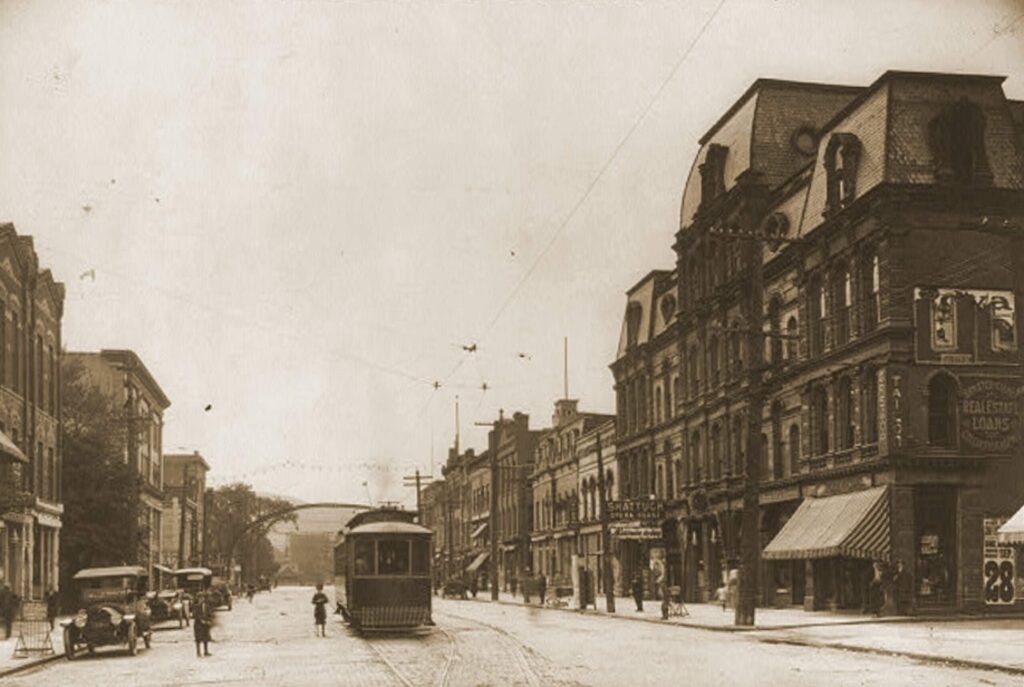The 1300-person venue opened in 1873 and was demolished in the 1940’s
By: Johanna Elattar
In the heart of Hornell, New York, where the hum of modern life and the rhythm of railroads create an unmistakable backdrop, there once stood a magnificent cultural landmark—the Shattuck Opera House. Though this regal venue no longer graces the skyline of the town, its story remains etched in the memories of those who lived during its prime. The opera house was more than just a building; it was a beacon of entertainment, community pride, and artistic ambition, shining brightly in the late 19th and early 20th centuries.
Today, its name might only be a whisper among the elderly, but the story of the Shattuck Opera House deserves to be remembered. From its grand opening in 1873 to its eventual demolition in the 1940s, the opera house was more than just an entertainment venue; it was a symbol of Hornell’s thriving cultural landscape. For a brief moment, it became the pulse of a town with big dreams, attracting renowned performers and leaving an indelible mark on the town’s history.
The Birth of the Shattuck Opera House
The opera house was the brainchild of Dr. Sewell Shattuck, a local dentist who believed in bringing the finest forms of entertainment to Hornell. Located on Broadway, the building was constructed with ambition in mind—an embodiment of the town’s desire to make a name for itself in the cultural world. When it opened its doors in 1873, the Shattuck Opera House was an architectural marvel of its time.
Standing proudly at 100 feet long, 60 feet wide, and 43 feet high, the four-story structure made a striking first impression. What made it unique was its concrete frame—a rarity for the time—which ensured both durability and grandeur. Inside, the opera house could seat over 1,300 patrons, an impressive number for a small town like Hornell.
Its lavish design included ornate interiors, a stage that could host the grandest of performances, and luxurious balconies that provided patrons with the best views. The opera house quickly became the go-to location for cultural events, attracting visitors from surrounding towns eager to experience high art.

A Cultural Mecca in Hornell
The Shattuck Opera House was much more than a mere venue; it was the cultural heartbeat of the town. Throughout its lifetime, it hosted a wide variety of performances, from operas to plays, vaudeville acts, and symphonic concerts. The names that graced its stage were impressive and spoke to the opera house’s high status. Legendary performers, including famed opera singer Lillian Russell, the Irish tenor John McCormack, and magicians like Harry Houdini, graced its stage, adding an air of sophistication and excitement to Hornell.
Not only did it serve as a stage for world-class performers, but it was also a gathering place where local talent could shine. The people of Hornell eagerly flocked to the opera house for special community events, lectures, and even political rallies. It wasn’t just a place to watch a show; it was a place where the town could come together and celebrate its own sense of identity and pride.
Perhaps one of the most significant moments in the opera house’s history was the arrival of the Russian Symphony Orchestra. A cultural milestone for a small town like Hornell, the orchestra’s performance solidified the opera house’s reputation as a cultural hotspot. It was a moment that would linger in the memories of those fortunate enough to witness it. Similarly, John Philip Sousa’s band played to a packed house, further elevating the town’s cultural standing.
The Transition to Cinema
As time passed, the entertainment world began to change. With the rise of the motion picture industry in the early 20th century, the once-glorious opera house faced increasing competition. The allure of cinema began to pull people away from live performances, and by the 1920s, the Shattuck Opera House was forced to adapt.
In 1926, the opera house was transformed into a movie theater, signaling the end of its days as a stage for live performances. The interior was modified to accommodate cinema, with new seating arrangements and the installation of the latest technology for film projection. The venue was rebranded as the Shattuck Theatre, and for a brief time, it seemed like this was the future of entertainment in Hornell.
However, the rise of film meant that the opera house’s days were numbered. The shift in entertainment preferences was too great, and by the 1930s, the Shattuck Opera House was no longer able to sustain itself. The grand dame of Hornell’s cultural life had become a relic of the past.
The End of an Era
In 1940, the opera house’s time came to a final, tragic end. After decades of serving as a cultural icon for the town, the building was sold for $41,283, and demolition began. A one-story building was erected in its place, marking the loss of a landmark that had meant so much to so many people.
The demolition of the Shattuck Opera House was not just the loss of a building but the loss of an entire era in Hornell’s history. The town’s cultural fabric had been irreparably changed, and the grand performances, the raucous applause, and the shared sense of community that the opera house once fostered seemed like distant memories.

Legacy of the Shattuck Opera House
While the Shattuck Opera House no longer stands, its legacy lives on in the hearts of those who remember its glory days. The opera house was not just a venue; it was a symbol of a time when small towns could dream big and make those dreams a reality. For a brief moment, Hornell was a cultural powerhouse, hosting the world’s greatest entertainers and forging connections between people from all walks of life.
In the decades that followed its demolition, Hornell changed, and many of its other landmarks followed the same fate as the opera house. Yet, the story of the Shattuck Opera House remains a testament to the ambition and spirit of a town that once dared to dream big.
Conclusion: Remembering a Cultural Treasure
As Hornell moves forward, it is essential to remember the Shattuck Opera House for what it represented—a time when art, culture, and entertainment brought the community together. Though the opera house no longer stands, its story continues to inspire those who seek to preserve the rich cultural history of the past while building a future that honors the town’s legacy.
Perhaps, one day, Hornell will once again find a place in its heart for grand performances, a place where the community can gather to share in the magic of the arts. Until then, the Shattuck Opera House lives on in the memories of those who were fortunate enough to experience its splendor. The echoes of its performances continue to reverberate in the streets of Hornell, a reminder of what once was and what might still be.
Johanna Elattar is an Arab and Muslim journalist, essayist, and academic whose investigative and human rights work was recently selected for inclusion in the Oxford University Press textbook Race and Racisms (4th Edition)—without submission. She writes unapologetically about marginalized communities, censorship, and the quiet violence of being silenced. For interviews, collaborations, or op-ed requests: 📩 Americangrrl70@gmail.com









